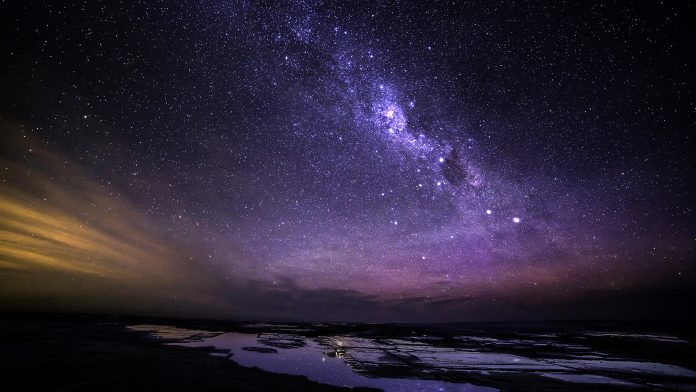Andrea Isella of the Department of Physics and Astronomy at Rice University discusses the search for baby planets and the astrophysics of planet formation.
As of today, the number of planets discovered orbiting stars beyond the solar system has surpassed 4,300, and statistical studies indicate that every star in the Milky Way hosts at least one planet (Cassan et al. 2012). Consequently, it is estimated that more than 100 billion planets exist in our galaxy alone. Beside this staggering number, the physical properties of the planets discovered so far, including the mass, size, and orbital radius, show an unexpected diversity. Noticeably, the two types of planets most commonly found around other stars – hot-Jupiters and super-Earths – are not present in our Solar System. On one hand, these discoveries indicate that the conditions necessary for the formation of planets must be easily achieved in the Milky Way. On the other, understanding the physical processes that control the formation of planets and their diversity has been an incredible struggle for more than 70 years. This has two main reasons. Firstly, the vast majority of known planets, including those in our Solar System, are older than 1 billion years, and, to make an analogy with the human life, they are in their adulthood and have lost most of their birth traits. Secondly, the regions in the Universe where planets are currently forming are relatively cold (10-1000 K), dense, and located at hundreds of light-years from Earth. These characteristics hamper our capability to study planet formation through direct observations.
Until the early 1990’s, our knowledge on planet formation was based on the study of pristine objects in our Solar System, such as comets and meteorites, that supposedly preserved their properties for more than 4.5 billion years. This situation changed with the development of ground-based interferometric techniques in the microwave part of the electromagnetic spectrum, between 0.5-5 mm, and with the launch of the Hubble Space Telescope (HST). The latter discovered hundreds of young stellar systems in star-forming regions in the solar neighbourhood (see, e.g., Robberto et al. 2013), while the former provided the long wavelengths necessary to peer through dense and cold material, as well as the angular resolution required to image the environment where planets were expected to form. However, only in the last few years, the steady technological improvement of astronomical instrumentation from optical to radio wavelengths has delivered the observational capabilities required to find baby planets and constrain the processes that control their formation.

The latter observations revealed the presence of two giant planets labelled as PDS 70 b and c, orbiting within the dust ring revealed by ALMA. The scale bar on the lower right indicates a spatial scale of 10 au.
To date, the most outstanding example of planetary system caught in act of forming was observed around the young star PDS 70, characterised by an estimated age of 5.4 million years and 80% of the mass of the Sun. Images of PDS 70 obtained with the Atacama Large Millimeter and sub-millimeter Array (ALMA) and the SPHERE and MUSE instruments at the Very Large Telescope (VLT), provide a snapshot of what our own Solar system might have looked like about 4.5 billion years ago. PDS 70 is located in the Upper Centaurus Lupus association at a distance of about 365 light-years (3.5×1015 km) from Earth and it is visible only from the Southern hemisphere. The star is surrounded by solid particles and gas molecules arranged in a donut-shaped rotating disk, also called protoplanetary disk, that extends out to about 200 astronomical units (au) from the central star (Fig. 1) (1 au is the mean distance between the Earth and the Sun) (Facchini et al. 2021). In the sky, the PDS 70 protoplanetary disk subtends an angle of only 3.5 arcseconds (1 arcsecond = 1/3600 degree), meaning that this object is about 500 times smaller than the full Moon.
The image on the left side of Fig. 1 shows the emission recorded at a wavelength of 0.86 mm with ALMA. It traces the location and measures the amount of small dust particles with sizes between about 0.1-1 mm (Keppler et al. 2019, Isella et al. 2019). The nature of these particles is primordial, meaning that they formed together with the central star and they will likely participate to the formation of larger bodies such as asteroids, comets, and, ultimately, planets. Measuring the amount of these dust particles across the protoplanetary disk informs about the processes that control the formation of planets. The right side of Fig. 1 shows instead a composite image obtained by combining ALMA and VLT observations. The MUSE and SPHERE instruments imaged the PDS 70 disk at optical and near-infrared wavelengths, respectively, and discovered two planets, labelled as PDS 70 b and c (Keppler et al. 2018, Haffert et al. 2020). Planet b is about 22 au from the central star, while planet c orbits farther out at about 33 au. The masses of these planets have been constrained to be between one and five times the mass of Jupiter (Wang et al. 2020). Theoretical studies suggest that planet b and c gravitationally perturbed the circumstellar dust and are responsible for the observed donut-shaped morphology observed by ALMA (Bae et al. 2020). Furthermore, ALMA observations revealed the presence of a circumplanetary disk made of small dust particles around planet c (Isella et al. 2019). The existence of circumplanetary disks around baby planets was long predicted based on the presence of Jupiter Galilean moons, but were never observed before. Ultimately, the discovery of PDS 70 b and c demonstrates that giant planets can form at tens of au from a star. This challenges the currently preferred theory of planet formation – the core accretion model (see, e.g., Rice & Armitage 2003) – which predicts instead that planets form by aggregation of small bodies only within 10-20 au from the central star, where these planet building blocks are the most abundant.

Recently, ALMA observations of protoplanetary disks have revealed many donut-shaped disks similar to PDS 70, but infrared observations have not been capable yet to detect the planets responsible for sculpting them. In particular, the ALMA “Disk Substructures at High Angular Resolution Project” (DSHARP, Andrews et al. 2018) has shown that systems with dust rings are common (see Fig. 2) and that these rings could have been carved by planets with masses similar to that of Saturn orbiting at tens of au from the central star (Zhang et al. 2018). Whereas these putative planets are too faint to be detected by current infrared instrumentation, they should be within the reach of the forthcoming NASA James Webb Space Telescope (JWST). Finding the predicted population of baby planets would demonstrate that systems like PDS 70 are not exceptional and would push for a fundamental revision of current planet formation theories.
While the search for baby planets continues within the capabilities provided by existing telescopes, understanding the formation of planets like Earth would require new and more powerful observatories like the proposed next generation Very Large Array (ngVLA). Strong of more than 300 radio telescopes spread across the United States and part of Mexico, the ngVLA will be ten times more sensitive and have ten times better resolution than ALMA at similar wavelengths. These unprecedented capabilities would allow us to image protoplanetary disks and see structures as small as a fraction of au, paving the way to discover planets like Earth as they form (Harter et al. 2020).
References
Andrews, S.~M. and 16 colleagues 2018. “The Disk Substructures at High Angular Resolution Project (DSHARP). I. Motivation, Sample, Calibration, and Overview.” The Astrophysical Journal 869.
Bae, J. and 9 colleagues 2019. “An Ideal Testbed for Planet-Disk Interaction: Two Giant Protoplanets in Resonance Shaping the PDS 70 Protoplanetary Disk.” The Astrophysical Journal 884.
Cassan, A. and 41 colleagues 2012. “One or more bound planets per Milky Way star from microlensing observations.” Nature 481, 167–169.
Facchini, S. and 6 colleagues, 2021, “The chemical inventory of the planet-hosting disk PDS 70.” The Astrophysical Journal, in press.
Harter, S. K., Ricci, L., Zhang, S., Zhu, Z. 2020. “Imaging the Dusty Substructures due to Terrestrial Planets in Planet-forming Disks with ALMA and the Next-generation Very Large Array.” The Astrophysical Journal 905.
Keppler, M. and 124 colleagues 2018. “Discovery of a planetary-mass companion within the gap of the transition disk around PDS 70.” Astronomy and Astrophysics 617.
Keppler, M. and 21 colleagues 2019. “Highly structured disk around the planet host PDS 70 revealed by high-angular resolution observations with ALMA.” Astronomy and Astrophysics 625.
Isella, A. and 13 colleagues 2018. “The Disk Substructures at High Angular Resolution Project (DSHARP). IX. A High-definition Study of the HD 163296 Planet-forming Disk.” The Astrophysical Journal 869.
Isella, A. and 6 colleagues 2019. “Detection of Continuum Submillimeter Emission Associated with Candidate Protoplanets.” The Astrophysical Journal 879.
Rice, W. K. M., Armitage, P.~J. 2003. “On the Formation Timescale and Core Masses of Gas Giant Planets.” The Astrophysical Journal 598.
Robberto, M. and 29 colleagues 2013. “The Hubble Space Telescope Treasury Program on the Orion Nebula Cluster.” The Astrophysical Journal Supplement Series 207.
Wang, J. J. and 44 colleagues 2020. “Keck/NIRC2 L’-band Imaging of Jovian-mass Accreting Protoplanets around PDS 70.” The Astronomical Journal 159.
Zhang, S. and 14 colleagues 2018. “The Disk Substructures at High Angular Resolution Project (DSHARP). VII. The Planet-Disk Interactions Interpretation.” The Astrophysical Journal 869.








